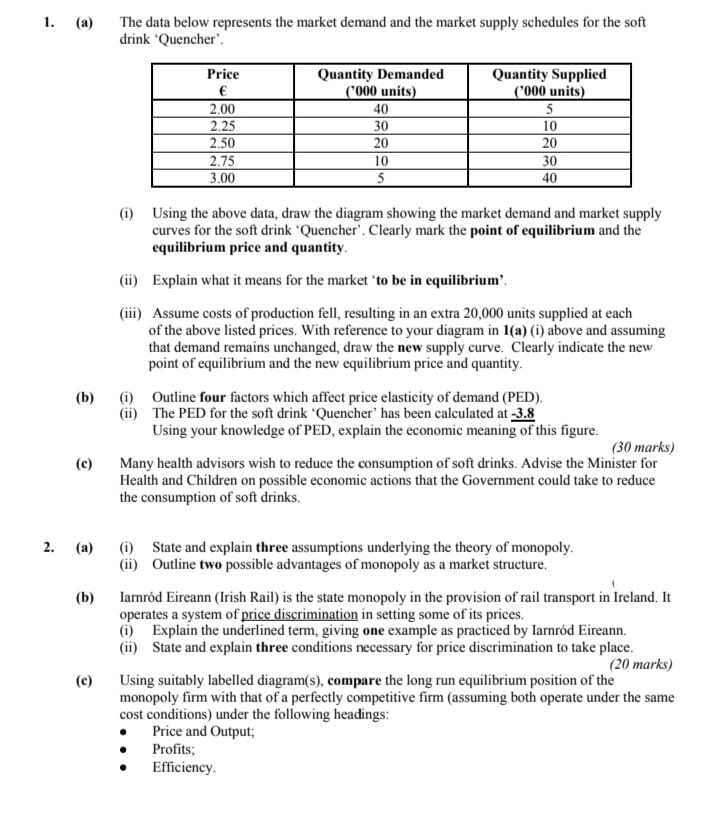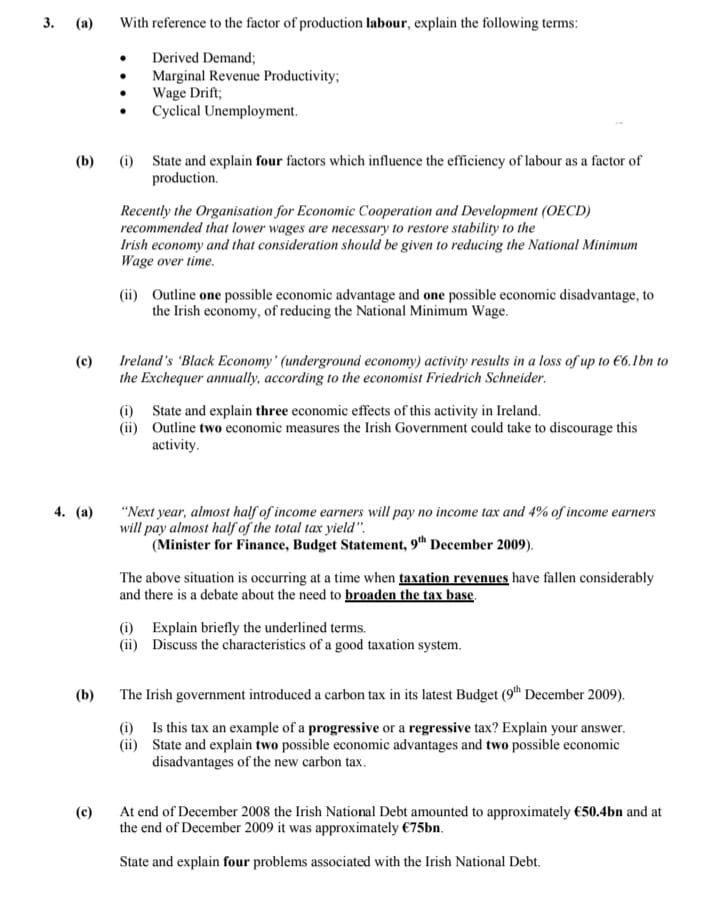1. (a) The data below represents the market demand and the market supply schedules for the soft drink "Quencher'. Price Quantity Demanded Quantity Supplied E ('000 units ('000 units 2.00 40 5 2.25 30 10 2.50 20 20 2.75 10 30 3.00 S 40 (i) Using the above data, draw the diagram showing the market demand and market supply curves for the soft drink "Quencher'. Clearly mark the point of equilibrium and the equilibrium price and quantity. (ii) Explain what it means for the market 'to be in equilibrium'. (iii) Assume costs of production fell, resulting in an extra 20,000 units supplied at each of the above listed prices. With reference to your diagram in 1(a) (i) above and assuming that demand remains unchanged, draw the new supply curve. Clearly indicate the new point of equilibrium and the new equilibrium price and quantity. (b) (i) Outline four factors which affect price elasticity of demand (PED). (ii) The PED for the soft drink "Quencher' has been calculated at 3.8 Using your knowledge of PED, explain the economic meaning of this figure. (30 marks) (c) Many health advisors wish to reduce the consumption of soft drinks. Advise the Minister for Health and Children on possible economic actions that the Government could take to reduce the consumption of soft drinks. 2. (a) (i) State and explain three assumptions underlying the theory of monopoly. (ii) Outline two possible advantages of monopoly as a market structure, (b) lamrod Eireann (Irish Rail) is the state monopoly in the provision of rail transport in Ireland. It operates a system of price discrimination in setting some of its prices. (i) Explain the underlined term, giving one example as practiced by larrod Eireann. (ii) State and explain three conditions necessary for price discrimination to take place. (20 marks) (c) Using suitably labelled diagram(s), compare the long run equilibrium position of the monopoly firm with that of a perfectly competitive firm (assuming both operate under the same cost conditions) under the following headings: Price and Output; Profits; Efficiency.3. (a) With reference to the factor of production labour, explain the following terms: Derived Demand; Marginal Revenue Productivity; Wage Drift; Cyclical Unemployment. (b) (i) State and explain four factors which influence the efficiency of labour as a factor of production. Recently the Organisation for Economic Cooperation and Development (OECD) recommended that lower wages are necessary to restore stability to the Irish economy and that consideration should be given to reducing the National Minimum Wage over time. (ii) Outline one possible economic advantage and one possible economic disadvantage, to the Irish economy, of reducing the National Minimum Wage. (c) Ireland's 'Black Economy' (underground economy) activity results in a loss of up to 66. Ibn to the Exchequer annually, according to the economist Friedrich Schneider. State and explain three economic effects of this activity in Ireland. (ii) Outline two economic measures the Irish Government could take to discourage this activity. 4. (a) "Next year, almost half of income earners will pay no income tax and 4% of income earners will pay almost half of the total tax yield". (Minister for Finance, Budget Statement, 9" December 2009). The above situation is occurring at a time when taxation revenues have fallen considerably and there is a debate about the need to broaden the tax base. (i) Explain briefly the underlined terms. (ii) Discuss the characteristics of a good taxation system. (b) The Irish government introduced a carbon tax in its latest Budget (9" December 2009). (i) Is this tax an example of a progressive or a regressive tax? Explain your answer. (ii) State and explain two possible economic advantages and two possible economic disadvantages of the new carbon tax. (c) At end of December 2008 the Irish National Debt amounted to approximately 650.4bn and at the end of December 2009 it was approximately 675bn. State and explain four problems associated with the Irish National Debt








